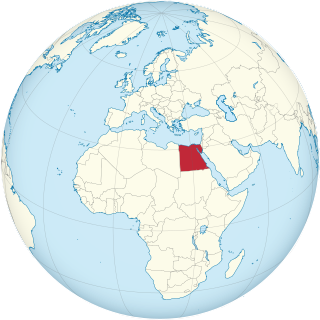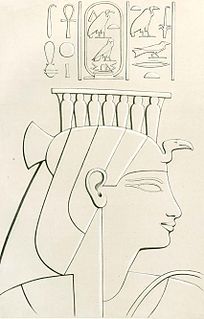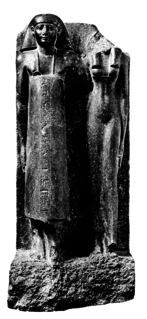| Hepu Vizier | |
|---|---|
| Dynasty | 18th Dynasty |
| Pharaoh | Tuthmosis IV |
| Wife | Rennai |
| Burial | Thebes TT66 |
Hepu was a vizier of ancient Egypt. [1] He served during the reign of Thutmose IV. [2]
Contents
| Hepu [1] in hieroglyphs |
|---|
| Hepu Vizier | |
|---|---|
| Dynasty | 18th Dynasty |
| Pharaoh | Tuthmosis IV |
| Wife | Rennai |
| Burial | Thebes TT66 |
Hepu was a vizier of ancient Egypt. [1] He served during the reign of Thutmose IV. [2]
| Hepu [1] in hieroglyphs |
|---|
Hepu's wife is named Rennai. A son is shown in TT66 offering to Hepu and Rennai. [1]
Hepu was buried in TT66 in Abd el Qurna in Thebes. The hall contains several scenes and one of them is a text of Hepu's installation as vizier before Thutmose IV. [1] [3] Another scene depicts the royal workshop with a statue of the King presenting a Djed pillar. [2]

Thutmose III was the sixth pharaoh of the Eighteenth Dynasty. Officially, Thutmose III ruled Egypt for almost 54 years and his reign is usually dated from 24 April 1479 BC to 11 March 1425 BC, from the age of two and until his death at age fifty-six; however, during the first 22 years of his reign, he was coregent with his stepmother and aunt, Hatshepsut, who was named the pharaoh. While he was shown first on surviving monuments, both were assigned the usual royal names and insignia and neither is given any obvious seniority over the other. Thutmose served as the head of Hatshepsut's armies. During the final two years of his reign, he appointed his son and successor, Amenhotep II, as his junior co-regent. His firstborn son and heir to the throne, Amenemhat, predeceased Thutmose III.

Articles related to Egypt include:

Thutmose IV was the 8th Pharaoh of the 18th dynasty of Egypt, who ruled in approximately the 14th century BC. His prenomen or royal name, Menkheperure, means "Established in forms is Re."

The New Kingdom, also referred to as the Egyptian Empire, is the period in ancient Egyptian history between the sixteenth century BC and the eleventh century BC, covering the eighteenth, nineteenth, and twentieth dynasties of Egypt. Radiocarbon dating places the exact beginning of the New Kingdom between 1570 BC and 1544 BC. The New Kingdom followed the Second Intermediate Period and was succeeded by the Third Intermediate Period. It was Egypt's most prosperous time and marked the peak of its power.

Mutemwiya was a minor wife of the Eighteenth Dynasty pharaoh Thutmose IV, and the mother of Pharaoh Amenhotep III. Mutemwiya's name means "Mut in the divine bark".

Nakht was an ancient Egyptian official who held the position of a scribe and astronomer of Amun, probably during the reign of Thutmose IV in the Eighteenth Dynasty. He is buried in the Theban Necropolis in tomb TT52.

The vizier was the highest official in ancient Egypt to serve the pharaoh (king) during the Old, Middle, and New Kingdoms. Vizier is the generally accepted rendering of ancient Egyptian tjati, tjaty etc., among Egyptologists. The Instruction of Rekhmire, a New Kingdom text, defines many of the duties of the tjaty, and lays down codes of behavior. The viziers were often appointed by the pharaoh. During the 4th Dynasty and early 5th Dynasty, viziers were exclusively drawn from the royal family; from the period around the reign of Neferirkare Kakai onwards, they were chosen according to loyalty and talent or inherited the position from their fathers.

The Ancient Egyptian noble Sennefer was "Mayor of the City" and "Overseer of the Granaries and Fields, Gardens and Cattle of Amun" during the reign of Amenhotep II of the Eighteenth Dynasty of Egypt. Being a favourite of the king he accumulated great wealth. He was also allowed to place a double statue of himself and his wife in the temple at Karnak. The famous garden plan, often described is Sennefer's Garden, is more likely to be of a garden which Sennefer managed, and perhaps designed, than to be of a garden which Sennefer owned.
The Installation of the vizier, alt. Instruction of Rekhmire, Regulation laid upon the vizier Rekhmire, is an ancient Egyptian text dating to the New Kingdom found in Rekhmire's tomb at Thebes. It describes the office of the Egyptian vizier, his appointment, his duties, his relationships to other officials, and how to behave.

Useramen was an ancient Egyptian vizier under pharaohs Hatshepsut and Thutmose III of the 18th Dynasty.

Menkheperreseneb II was a High Priest of Amun, Superintendent of the Gold and silver treasuries, and Chief of the Overseers of Craftsmen. He served at the time of Thutmose III and Amenhotep II, and may have been buried in his Theban tomb, TT112.
Amethu called Ahmose was a vizier of ancient Egypt. He served during the reign of Thutmose II and the early years of the reign of Hatshepsut and Thutmose III of the 18th Dynasty.
Amenemipet called Pairy was a Vizier of ancient Egypt. He served during the reign of Amenhotep II and Tuthmosis IV.
The Theban Tomb TT22 is located in Sheikh Abd el-Qurna, part of the Theban Necropolis, on the west bank of the Nile, opposite to Luxor. It is the burial place of the Ancient Egyptian Wah, who was royal butler during the early eighteenth Dynasty.
The Theban Tomb TT172 is located in El-Khokha, part of the Theban Necropolis, on the west bank of the Nile, opposite to Luxor.

The Eighteenth Dynasty of Egypt is classified as the first dynasty of the New Kingdom of Egypt, the era in which ancient Egypt achieved the peak of its power. The Eighteenth Dynasty spanned the period from 1549/1550 to 1292 BC. This dynasty is also known as the Thutmosid Dynasty for the four pharaohs named Thutmose.
Articles related to ancient Egypt include:
The Theban Tomb TT66 is located in Sheikh Abd el-Qurna. It forms part of the Theban Necropolis, situated on the west bank of the Nile opposite Luxor. The tomb is the burial place of the Ancient Egyptian Vizier Hepu who served during the reign of Tuthmosis IV.
Nebweben was an ancient Egyptian vizier of the North under pharaoh Thutmose III of the 18th Dynasty.

The Theban Tomb TT83 is located in Sheikh Abd el-Qurna, part of the Theban Necropolis, on the west bank of the Nile, opposite to Luxor. It is the burial place of the Ancient Egyptian official, Amethu called Ahmose who was the Governor of the town and Vizier. Amethu called Ahmose dates to the Eighteenth dynasty of Egypt, from the time of Tuthmosis III.
| This Ancient Egypt biographical article is a stub. You can help Wikipedia by expanding it. |